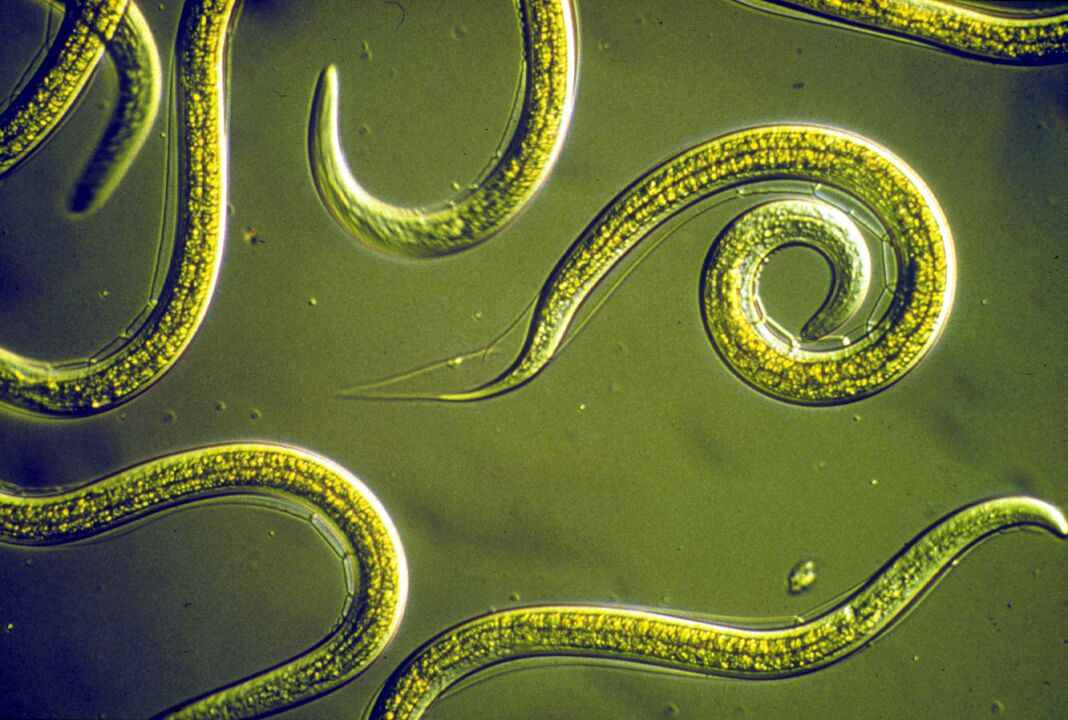Anyone can experience the worm infection. Toddlers - kindergarteners, adults - for other reasons. Despite all the preventive measures, you need to know the signs of worms in people in order to notice the disease in time and start treating it. What worms are, where they settle and how they manifest - we'll look at them in more detail.
What organs can be affected by worms?

There are two types of invasion: abdominal and tissue. Depending on the species, the habitats are also divided into:
- Hollow worms settle in the small and large intestines. In particular, the first stages of the small intestine are affected by a broad tapeworm, hookworm, and tapeworm. The lower part of the small intestine is home to the dwarf tapeworm, pinworm. The colon most often becomes a habitat for the whipworm.
- Tissue helminths affect any type of organ: liver, brain, lymph nodes, bile ducts.
Important! It is impossible to determine the signs of the presence of worms in the patient in the early stages of the invasion. While the number of worms is small, the poisoning of waste products is within the normal range, the body itself copes with the invasion. The appearance of characteristic or acute symptoms indicates a significant increase in the number of helminthic invasions: the maturation and dynamic development of individuals.
Types of chains

When determining the signs of worms in adults, you need to understand what invasion we are talking about:
- Vlasoglavy. The chains were named after the filamentous body, the back end of which was thickened. The life cycle of parasites is direct. Habitat - tropics, subtropics. The chains are localized in the cecum and are therefore difficult to etch.
- Nematode. A suborder of nematodes living in nature and in the human body. The most famous representatives: tapeworms, pinworms.
- Luck. Flat type gingerbread. They pose a huge threat to the carrier's body, as they can settle in any organ or system. Representatives: schistosomiasis, opisthorchiasis worms.
- Swine tapeworm (tapeworm). Tapeworms are hermaphrodites. With strong hooks on the head to attach to the walls, they can affect the brain, intestines, liver, eyes, muscles. Consequences of failure to treat: paralysis, death of the carrier.
All types of worms are found in the human body. After developing ascariasis, enterobiasis, diphyllobothriasis, the patient experiences a lack of nutrients, the intestines do not absorb food residues normally. Consequences of invasion: metabolic disorders, neurohumoral reactions.
Some facts about the ways of infection:
- Ascariasis - unwashed vegetables, fruits, hands;
- Raw or lightly salted fish, caviar - diphyllobothriasis;
- Pinworms - contact household method. The development period is up to 60 days, followed by a chronic phase of invasion, characterized by a decrease in immunity and a high incidence of infectious diseases, exacerbation of chronic processes.
Signs of worms in humans
The general symptoms of worms in adults depend on the location of the helminths. The main threat is parasites that settle in vital organs. Worms appeared, symptoms implicit: weakness, cough. And although a full diagnosis requires an examination. However, there are a number of signs you can use to determine where the worms are and whether they exist at all.
Brain

Most often, there are no obvious symptoms, but if worms live in the human brain, the patient may experience:
- persistent nausea;
- frequent vomiting;
- severe weakness;
- lethargy of consciousness;
- decreased visual acuity, hearing;
- fluctuations in body temperature for no apparent reason;
- epilepsy.
Fact! Most often, parasites in the brain are only found after an autopsy.
In the body

Hundreds of known parasite species can settle in a patient's body. It is difficult to determine the presence of worms in an adult’s body. Symptoms vary depending on the localization: heart, liver, lungs, subcutaneous tissue. Common signs of worms in adults:
- muscle and joint pain;
- deterioration of the skin;
- weight jumps: reduction or adjustment;
- severe persistent fatigue;
- immediate decrease in immunity.
Fact! Some worms are able to climb from the anus to the barrier, penetrate the bloodstream into other organs, appear in the abdominal cavity, and affect the nose and ears.
In the intestines

The most common worms in humans, with more pronounced symptoms, can be in the colon and small intestine. Infection occurs through oral contact. The developmental period of larvae and imago eggs occurs in the intestinal mucosa. The parasite absorbs nutrients, preventing them from being absorbed in the intestines. Because of this, there are intestinal problems that cause intestinal worms in adults. Symptoms:
- the stomach is often swollen;
- the stool is broken;
- bloating appears;
- changes in body weight;
- he wants to eat constantly and strongly.
Of course, in worms, the symptoms may be different, overgrown with characteristic signs of stomach disease, if the patient has one. This is why proper diagnostic measures are so important. Only a specialist will determine exactly where the worm is located, the type of invasion, and the dynamics of its development.
Signs of helminthiasis depending on the type of parasite
The symptoms of worms in adults may be different from those in childhood. Strong immunity repels the invasion, but the child does not have such a trait. Knowing the signs of the presence of worms in a person will make it easier to understand the cause of the disease and consult a doctor if the infection is first suspected. An infectious disease specialist, parasitologist, helminthologist - the right profile specialist will quickly figure out where worms live in the human body and how to get rid of them.
Each parasite causes its own symptoms:
- tapeworm problems include intestinal problems: loss of appetite, sleep disturbances, bloating;
- round - cough, bloating, flatulence, loss of appetite.
Important! The tapeworms or tapeworms grow to 40 cm in length and can easily move along the intestinal wall, living in the lungs and liver. This is a very dangerous invasion that must be destroyed.
Whether or not tapeworms are established in the human body, they must be removed. Invasion, even in minimal amounts, can cause severe damage to the body, and large numbers of parasites poison the host and often lead to the death of the patient. Knowing where the worms live should not rush to describe frequent bloating due to normal indigestion, perhaps this is a sign of helminthiasis, which means it’s time to see a doctor.






































